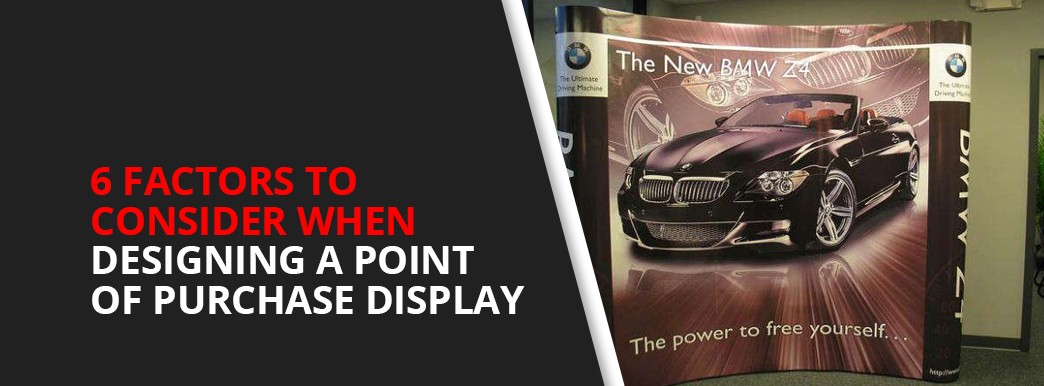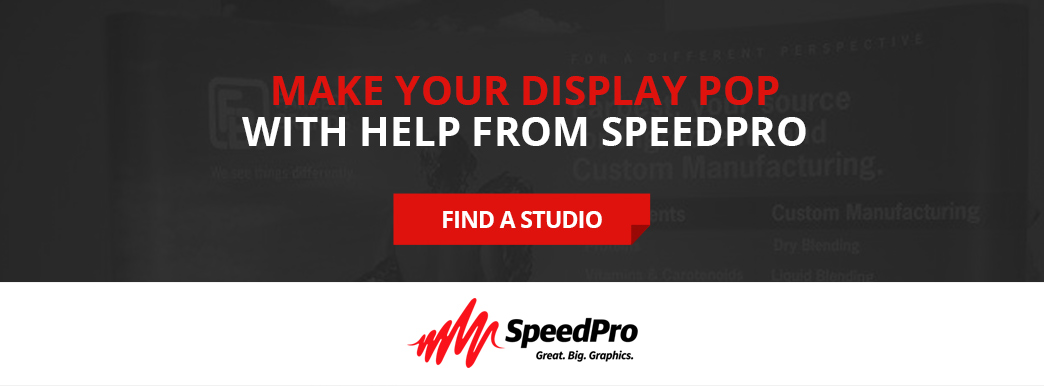
6 Factors to Consider When Designing a Point of Purchase Display
MAY 25, 2020| SpeedProPoint of purchase (POP) displays are designed to appeal to customers right at the place and time they make a purchase decision. Point of sale displays are a type of POP display, but they are always positioned near the checkout area where the sale transaction takes place. POP displays can be positioned anywhere throughout a store.
POP displays can help raise awareness, increase interest, stir desire or motivate action. POP displays can be one of the most underutilized tools in retail. So, how can you start taking advantage of POP displays? To design an effective POP display, consider these six factors.
1. Form
The first thing you want to think through is what form your POP display will take. POP displays come in many forms. Some options to consider include:
- Banners: Banners are great at attracting attention. You can hang banners from the ceiling or use a banner stand to display your banner wherever you want.
- Attachable shelving: Some POP displays can attach to shelving to grab a person’s attention as they walk down the store aisle. These tend to be smaller displays but can be very effective.
- Tablet stands or kiosks: For a high-tech POP display, use a kiosk or tablet stand. This tends to be a good idea near the checkout so it engages customers while they are waiting in line.
- Clings and decals: If the product you want to highlight is positioned near a window, glass panel or another smooth surface, you can use a decal to advertise the product.
- Easel-back standups: Cardboard cutouts are great at attracting attention. You can create an easel-backed standup display featuring the product’s spokesperson, for example.
- Product glorifier: A product glorifier is a display that provides a backdrop or a surrounding for a product to show it off. These displays come in all shapes and sizes, some of which may include shelving.
2. Placement
You also need to think about where you are going to place your POP display. Remember that a POP display should always be positioned near the product being advertised. Some options to consider include:
- On endcap: Endcap displays can be a great way to attract attention to a product you want to highlight. These displays can take many forms. If they’re eye-catching enough, you can get shoppers to pause as they walk past the aisle to see what is being advertised, and they just might add that product to their cart.
- On aisle shelving: You can also add POP displays to shelving in an aisle. This is an effective strategy for drawing customers’ focus to the product being advertised over other products nearby. When they’re in the cereal aisle of a grocery store, a colorful display highlighting one type may encourage them to reach for that box.
- Hanging from the ceiling: Another option is to install your signage overhead by hanging it from the ceiling. This works well for signs and banners. Especially if you have drop ceiling tiles, hanging displays is easy and can be a great way to draw attention to a product just underneath.
3. Size
Size is another important aspect of your POP display to consider. Once you know where you are going to place your display, you can determine the best size for that location. A hanging sign or easel-back standup could be quite large, while displays attached to shelving tend to be on the smaller side.
There is no one-size-fits-all dimensions to use for POP displays. The key is to choose a size that makes sense for your display. You want it to be large enough to be noticed but small enough that it won’t obscure products on the shelf.
4. Material
Material is another factor to consider for POP displays. Once you’ve chosen what form your display will take, you can select from materials that make sense for that display type. Some examples of material choices you might consider include:
- Fabric: Fabric displays have a premium look that makes them an ideal choice for advertising high-end products or for stores with an elegant atmosphere. You can choose fabric for standing and hanging banners and for large panel displays.
- Vinyl: Vinyl is a popular choice for many displays, especially banners and decals. Vinyl is affordable, weather-resistant and easy to wipe clean, all of which make it a versatile choice for many locations.
- Cardboard: Cardboard is an affordable and practical choice for POP displays attached to shelving or for displays designed to surround the product being advertised. It also works great for easel-backed cutouts.
- Foam core: Foam core is made from foam covered in paper. It is an exceptionally lightweight material and is rigid, making it a great choice for hanging from the ceiling or for displaying on an easel.
5. Text
The text you include in your POP display should be carefully chosen and designed to convert customers right in that instant. This is no easy task, but along with the right graphic design — which we’ll discuss next — it is possible. Keep in mind that for maximum impact, you want minimal words. Create a message that is powerful and succinct. Remember, this text should call the customer to action. For example, you could prompt shoppers to “Try our new flavor!” or “See what the perfect pair of slippers feel like.”
In some cases, you may just want to use your POP display to draw attention visually and generate interest without appealing to the customer through text. In these cases, make sure the product’s branding is prominently featured. Always choose a color, font and pitch that make your text readable and allow it to stand out from the display’s background.
6. Graphics
Graphics are a crucial aspect of your display. The graphics should be on-brand for the product, but they should also be designed to capture attention. This means using bold, contrasting colors and eye-catching images. This is especially important for smaller displays since they can otherwise be overlooked.
Your display can be primarily text-based, in which case you should focus on using large, bold text that people can’t miss. If you want to include imagery into your design, consider what types of visuals will convert your customers. For hiking boots, maybe you need mountains to transport them to the place where they would be using the product. For a jar of jelly, maybe they need to see it spread on a delicious-looking piece of buttered toast. Determine what makes the most sense for the product you want to move.
Make Your Display Pop With Help From SpeedPro
At SpeedPro, we want to help you bring your vision for your POP display to life. That means paying careful attention to what you want and asking the right questions to help you choose the right materials, size and other specifications. When you want bold graphics that will grab your customers’ attention, SpeedPro is the ideal printing partner. To get started, find a SpeedPro studio near you today.

















![Materials for POP displays [list]](https://www.speedpro.com/wp-content/uploads/2020/05/02-Material.jpg)
